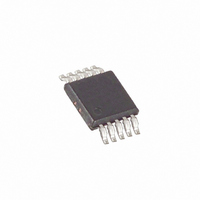MAX6650EUB+T Maxim Integrated Products, MAX6650EUB+T Datasheet - Page 22

MAX6650EUB+T
Manufacturer Part Number
MAX6650EUB+T
Description
IC REG FAN SPEED 10-MSOP
Manufacturer
Maxim Integrated Products
Datasheet
1.MAX6650EUBT.pdf
(25 pages)
Specifications of MAX6650EUB+T
Applications
Fan Controller, Brushless (BLDC)
Number Of Outputs
1
Voltage - Load
0.3 V ~ 5.2 V
Voltage - Supply
3 V ~ 5.5 V
Operating Temperature
-40°C ~ 85°C
Mounting Type
Surface Mount
Package / Case
10-MSOP, Micro10™, 10-uMAX, 10-uSOP
Operating Supply Voltage
3 V to 5.5 V
Lead Free Status / RoHS Status
Lead free / RoHS Compliant
Current - Output
-
Lead Free Status / Rohs Status
Lead free / RoHS Compliant
Other names
MAX6650EUB+T
MAX6650EUB+TTR
MAX6650EUB+TTR
We will start with K
could be tried, or to improve response time, a 1 could
be tried).
Second, calculate the appropriate value for the Speed
Register (K
• Set FanSpeed = 25RPS (1500PRM/60).
• Solving for equation 2 gives K
To monitor the fan speed using the SMBus/I
step is to determine the tachometer count time. In sys-
tems running in open-loop mode, this is necessary. In
closed-loop or full-speed mode, reading the tachome-
ter can serve as a valuable check to ensure the fan and
the control loop are operating properly.
The MAX6650/MAX6651 use an 8-bit counter to count
the tachometer pulses. This means the device can
count from 0 to 255 tachometer pulses before overflow-
ing. The MAX6650/MAX6651 can accommodate a large
range of fan speeds by allowing the counting interval to
be programmed. Smaller/faster fans should use smaller
count times. Although larger fans could also use small-
er count times, resolution would suffer. Choose the
slowest count time that will not overflow under worst-
case conditions. Fans are mechanical devices, and
their speeds are subject to large tolerance variations. If
an overflow does occur, the counter will read 255. The
MAX6650/MAX6651 can be configured to generate an
alert if an overflow is encountered (see Setting Up
Alarms ). Note that the prescaler value has no effect on
the TACH0 register.
Enter the appropriate count-time value in the tachometer
count-time register.
Example:
Assume a 12V fan rated at 2000 RPM.
To accommodate large tolerance variations, choose a
count time appropriate for a maximum speed of
3000RPM; 3000RPM is 50RPS and generates a 100Hz
(2 pulses/revolution) tachometer signal. Table 9 indi-
cates a count time of 2s will optimize resolution. With a
2s count time, speeds as fast as 3825RPM can be
monitored without overflow. The minimum resolution will
be 15RPM or 0.75% of the rated speed of 2000RPM.
To increase versatility, the MAX6650/MAX6651 have
two and five general-purpose digital inputs/outputs,
respectively. These GPIOs can be configured through
the SMBus/I
Fan-Speed Regulators and Monitors
with SMBus/I
22
= 2, K
K = 4.
Determining the Tachometer Count Time
______________________________________________________________________________________
TACH
TACH
2
C.
= 39 for K
) using equation 2.
SCALE
SCALE
= 2 (to increase stability, a 4
Setting Up the GPIOs
= 1, or K
2
TACH
C-Compatible Interface
= 78 for K
TACH
2
C, the next
= 158 for
SCALE
All GPIOs can be configured to output a logic-level low.
The MAX6650/MAX6651 are designed to sink up to
10mA. This high sink current can be especially useful
for driving LEDs.
On the MAX6651, for GPIO3 and GPIO4, write a zero to
the appropriate location in the GPIO definition register.
For GPIO0, GPIO1, and (MAX6551 only) GPIO2, write a
10 to the appropriate location in the GPIO definition
register.
All GPIOs can be configured to generate a logic-level
high. An output high is generated using an open-drain
output stage with an internal pullup resistor of nominally
100kΩ. The MAX6650/MAX6651 power-up default state
is with all GPIOs configured as output highs.
On the MAX6651, for GPIO3 and GPIO4, write a 1 to
the appropriate location in the GPIO definition register.
For GPIO0, GPIO1, and (MAX6551 only) GPIO2, write
an 11 to the appropriate location in the GPIO definition
register.
Since a logic-level high output is open drain with an
internal pullup, an external device can actively pull this
pin low. The MAX6650/MAX6651 allow the user to read
the GPIO value through the GPIO status register.
• Configure the GPIO as an output logic level high (see
• Read the state of the GPIO by reading the GPIO sta-
GPIO0 can also serve as an ALERT output. The ALERT
output is designed to drive an interrupt on a µC. The
ALERT output goes low whenever an enabled alarm
condition occurs (see Setting Up Alarms ).
Configure GPIO0 as an ALERT output by writing a 01 to
bits 1 and 0 of the GPIO definition register.
GPIO1 can also be configured as a full-on input. When
the full-on pin is pulled low, the MAX6650/MAX6651
apply the full available voltage across the fan. This hap-
pens independently of the software mode of operation.
This is a particularly valuable feature in high-reliability
systems, designed to prevent software malfunctions
from causing system overheating.
Configure GPIO1 as a full-on input by writing a 01 to
bits 3 and 2 of the GPIO definition register.
above).
tus register.
Digital Out High
Digital Out Low
Full-On Input
Alert Output
Digital Input






